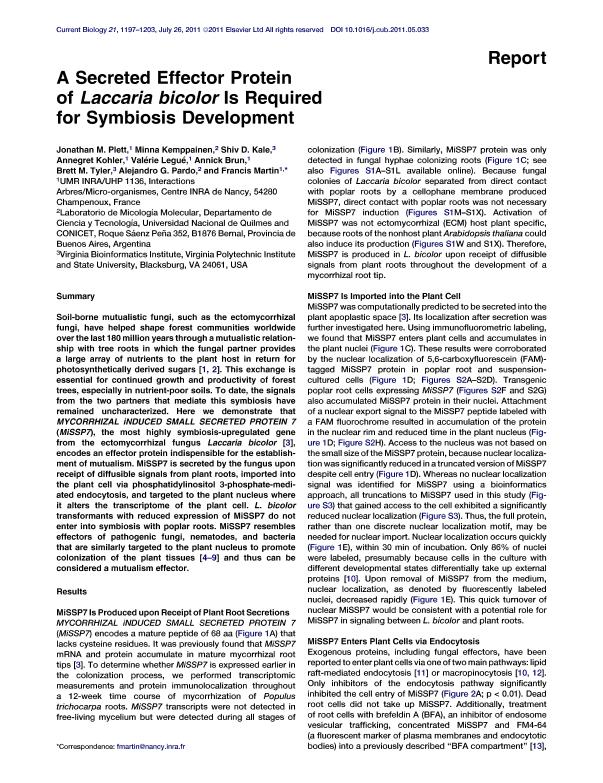Artículo
A secreted effector protein of laccaria bicolor is required for symbiosis development
Plett, Jonathan M.; Kemppainen, Minna Johanna ; Kale, Shiv D.; Kohler, Annegret; Legué, Valérie; Brun, Annick; Tyler, Brett M.; Pardo, Alejandro Guillermo
; Kale, Shiv D.; Kohler, Annegret; Legué, Valérie; Brun, Annick; Tyler, Brett M.; Pardo, Alejandro Guillermo ; Martin, Francis
; Martin, Francis
 ; Kale, Shiv D.; Kohler, Annegret; Legué, Valérie; Brun, Annick; Tyler, Brett M.; Pardo, Alejandro Guillermo
; Kale, Shiv D.; Kohler, Annegret; Legué, Valérie; Brun, Annick; Tyler, Brett M.; Pardo, Alejandro Guillermo ; Martin, Francis
; Martin, Francis
Fecha de publicación:
07/2011
Editorial:
Cell Press
Revista:
Current Biology
ISSN:
0960-9822
Idioma:
Inglés
Tipo de recurso:
Artículo publicado
Clasificación temática:
Resumen
Soil-borne mutualistic fungi, such as the ectomycorrhizal fungi, have helped shape forest communities worldwide over the last 180 million years through a mutualistic relationship with tree roots in which the fungal partner provides a large array of nutrients to the plant host in return for photosynthetically derived sugars [1, 2]. This exchange is essential for continued growth and productivity of forest trees, especially in nutrient-poor soils. To date, the signals from the two partners that mediate this symbiosis have remained uncharacterized. Here we demonstrate that MYCORRHIZAL iNDUCED SMALL SECRETED PROTEIN 7 (MiSSP7), the most highly symbiosis-upregulated gene from the ectomycorrhizal fungus Laccaria bicolor [3], encodes an effector protein indispensible for the establishment of mutualism. MiSSP7 is secreted by the fungus upon receipt of diffusible signals from plant roots, imported into the plant cell via phosphatidylinositol 3-phosphate-mediated endocytosis, and targeted to the plant nucleus where it alters the transcriptome of the plant cell. L. bicolor transformants with reduced expression of MiSSP7 do not enter into symbiosis with poplar roots. MiSSP7 resembles effectors of pathogenic fungi, nematodes, and bacteria that are similarly targeted to the plant nucleus to promote colonization of the plant tissues [4-9] and thus can be considered a mutualism effector.
Palabras clave:
Laccaria
,
MiSSP7
,
Ectomycorrhiza
,
Symbiosis
Archivos asociados
Licencia
Identificadores
Colecciones
Articulos(SEDE CENTRAL)
Articulos de SEDE CENTRAL
Articulos de SEDE CENTRAL
Citación
Plett, Jonathan M.; Kemppainen, Minna Johanna; Kale, Shiv D.; Kohler, Annegret; Legué, Valérie; et al.; A secreted effector protein of laccaria bicolor is required for symbiosis development; Cell Press; Current Biology; 21; 14; 7-2011; 1197-1203
Compartir
Altmétricas



